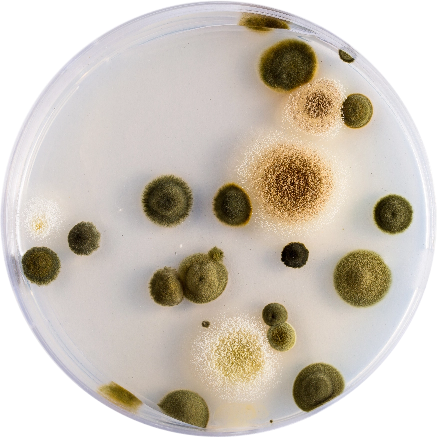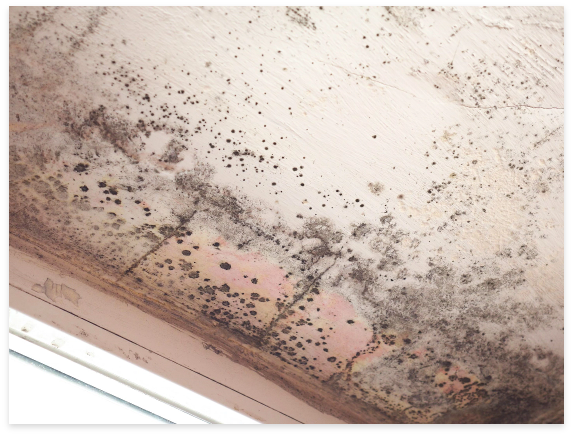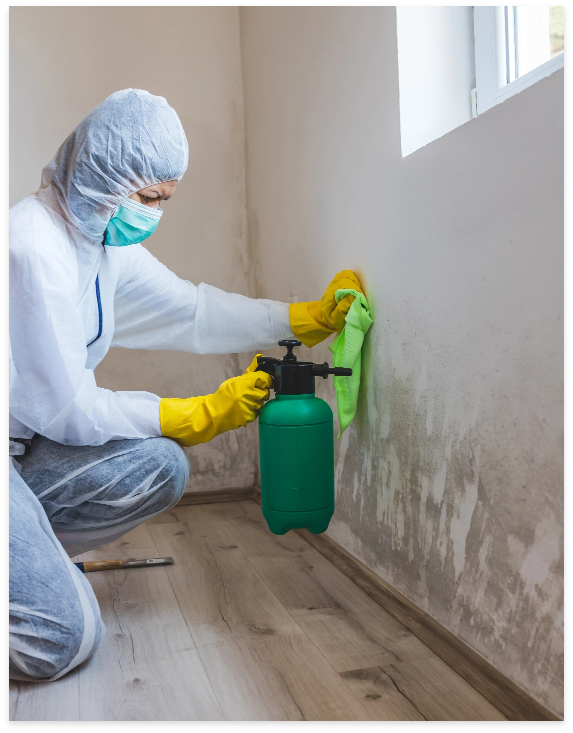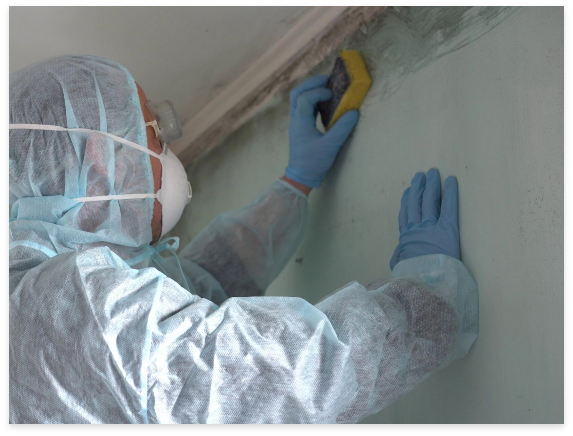Fueled by moisture, the formation of mold is as natural as breathing. But that’s not a consolation when you spot it where it doesn’t belong: In your home or place of business, sharing the air you breathe and compromising air quality. Unsightly, smelly and potentially dangerous (in large quantities) mold spores are always an unwelcome guest. If you require mold remediation, Staples Consulting Group can serve as an all-in-one solution.
Specializing in residential and commercial losses, Staples Consulting Group is a one-stop shop for virtually all of the damage challenges that require resources to resolve. In business since 2008, we bring together mold inspectors/remediators, estimators, insurance adjusters and more to help put your property back into pre-loss condition — from comprehensive mold inspection to improving air quality.

What is mold?
Mold is a type of fungus that can be found virtually anywhere where a combination of dampness, humidity, darkness and surfaces exist. As a living organism, mold can grow, and when it’s in indoor settings, it can reproduce very quickly, clinging to walls, floors, ceilings, furniture and more. The key to that growth is moisture, which it uses as a source of energy. They reproduce by releasing spores, which serve as building blocks for populating.
What does mold look like?
If you’ve ever cleaned out your refrigerator of uneaten leftovers or condiments, you have likely seen mold up close and personal. It’s an eyesore — and can smell even worse. Depending on its type, mold can come in various colors, such as white, green, black, green and brown. It can also appear fuzzy and jagged in its formation, especially when it clings to walls. It’s highly unattractive and can be difficult to get rid of once it’s spotted. It can sometimes be difficult to detect, making comprehensive mold inspection important in the event mold spores are found. Carpet, wood, food and paper are all feeding grounds for the far-reaching tentacles of mold.

Is mold dangerous?
Beyond its unsightly appearance, mold can also be dangerous, particularly for those who are immunocompromised or have allergies. Because mold releases toxins into the air — which are called mycotoxins — it can be dangerous to be in rooms where it’s found in large quantities. It can also lead to the formation of allergies and trigger respiratory problems. According to the Environmental Protection Agency, common symptoms associated with mold exposure may include:
Types of Mold
- Aspergillus
- Cladosporium
- Penicillium
- Stachybotrys chartarum
- Alternaria

Aspergillus
This is a type of fungus that is so omnipresent that people breathe it in every day since it’s found in both outdoor and indoor environments where dampness and moisture co-exist. While it’s not generally considered harmful to those who are healthy, people with weakened immune systems may develop breathing problems.
Cladosporium
Cladosporium is among the more common indoor molds that exist. Black in color (but not black mold), Cladosporium isn’t considered toxic but people with allergies can be sensitive to the gases it gives off. It’s known to grow on walls, fabrics and floors.
Penicillium
Helping to produce the first antibiotic, penicillium has some redeeming qualities, but it’s not something you want growing in your house or business. It’s commonly found on foods when they spoil and the spores are green and blue. It thrives in moisture-filled environments, both indoors and outdoors.
Stachybotrys chartarum
Also known as black mold, Stachbotrys chartarum is the most problematic of mold spores. Black mold frequently grows in properties that are water damaged, such as one that might be impacted by flooding, fire restoration or unaddressed leaks. In addition to forming on walls, wood and floors, it can also develop in insulation, making it difficult to know for sure if it’s been fully removed even if all visible mold has been addressed. Potential health problems linked to black mold include headaches, respiratory issues to more serious complications, such as those affecting the brain and bleeding in the lungs.
The toxicity of black mold makes mold remediation a priority once it’s detected. A professional mold inspection is highly recommended, which may include mold testing to verify that it’s Stachbotrys chartarum.The toxicity of black mold makes mold remediation a priority once it’s detected. A professional mold inspection is highly recommended, which may include mold testing to verify that it’s Stachbotrys chartarum.
Alternaria
Alternaria is another fungus that can be found in many different environments, including the air, soil and on plant life, such as crops that produce grains and vegetables. Like most other molds, Alternaria populates in damp places, making it a common sight in rooms like bathrooms and basements.

What is mold remediation?
Mold remediation is a multi-pronged inspection process that is designed to neutralize mold growth once it’s spotted. Involving inspection, mold testing, cleaning and wholesale removal. The first phase of remediation is inspection. Here, the professional uses their equipment and familiarity with mold identification to spot fungus and where it may be lurking that isn’t visible to the naked eye. Once a comprehensive inspection is finished — which may involve several different rooms and/or behind walls — a plan is put together to remove the mold spores and prevent them from coming back. This task may include:
- Cleaning and disinfecting surfaces
- Removing and replacing contaminated materials
- Assessing why problematic areas are producing excess moisture.
- Installing a solution that can make vulnerable areas drier and improve moisture control.
How do you minimize mold?
Mold can’t be prevented entirely since it’s a naturally occurring process that manifests itself wherever there’s moisture (which is everywhere). Because of this, mold inspection is often conducted once mold has already become a problem that requires professional attention. But there are things you can do to improve mold control, which is recommended by the Environmental Protection Agency:
- Ensure spills and leaks are cleaned or fixed promptly.
- Ensure the ground slopes away from the foundation to avoid water from collecting along the foundation and entering the basement.
- Double-check that all windows are fully closed when it’s raining out.
- Keep indoor air humidity levels controlled.
- The EPA recommends no more than 50%.
- Look for condensation forming along windows, mirrors, walls or pipes. Condensation forms wherever there’s excess moisture.
There are also actions you can take that can reduce humidity in your house, apartment or office. Smart solutions include venting appliances that produce moisture, such as stoves, kerosene heaters and clothes dryers. Turning on a fan in the bathroom while showering can also help to minimize the steam that’s produced by hot running water. You may also want to check shower curtains, as they too can produce mold spores given how wet they can get combined with minimal ventilation.
How much does mold remediation cost?
The hidden nature of mold makes it something that can be difficult to remove in its entirety once it’s spotted. This is why mold remediation is highly recommended, as experts have the training and know-how to detect it and eliminate it in hard-to-reach places.
The cost for this service can be wide-ranging and will depend on the extent of the damage, the rates of the service provider and the complexity of removal.

Is mold remediation covered by insurance?
Whether an insurer will pay for the cost of mold removal is determined by the insurance policy itself and the policies of the insurer. Some insurers stipulate that they don’t cover the cost of mold removal under any circumstances. But most do, so long as the mold stemmed from a covered peril. This means that the mold had to have come about because of something like a burst pipe or a natural disaster. An insurance adjuster may be involved in this determination if you decide to file a claim.
In instances where mold removal is underwritten, you will likely still need to pay for the deductible.
If you’ve contacted your insurer about mold removal — or you plan on doing so — Staples Consulting Group can assist you with the process. We handle all sorts of property loss claims including and beyond mold, such as flood, hurricane, smoke, theft and more. Our detailed claims analysis and thorough site inspections can help you get your property back into pre-loss condition. If you live or work in Texas, Alabama, Mississippi, Florida or Louisiana, please contact us.





